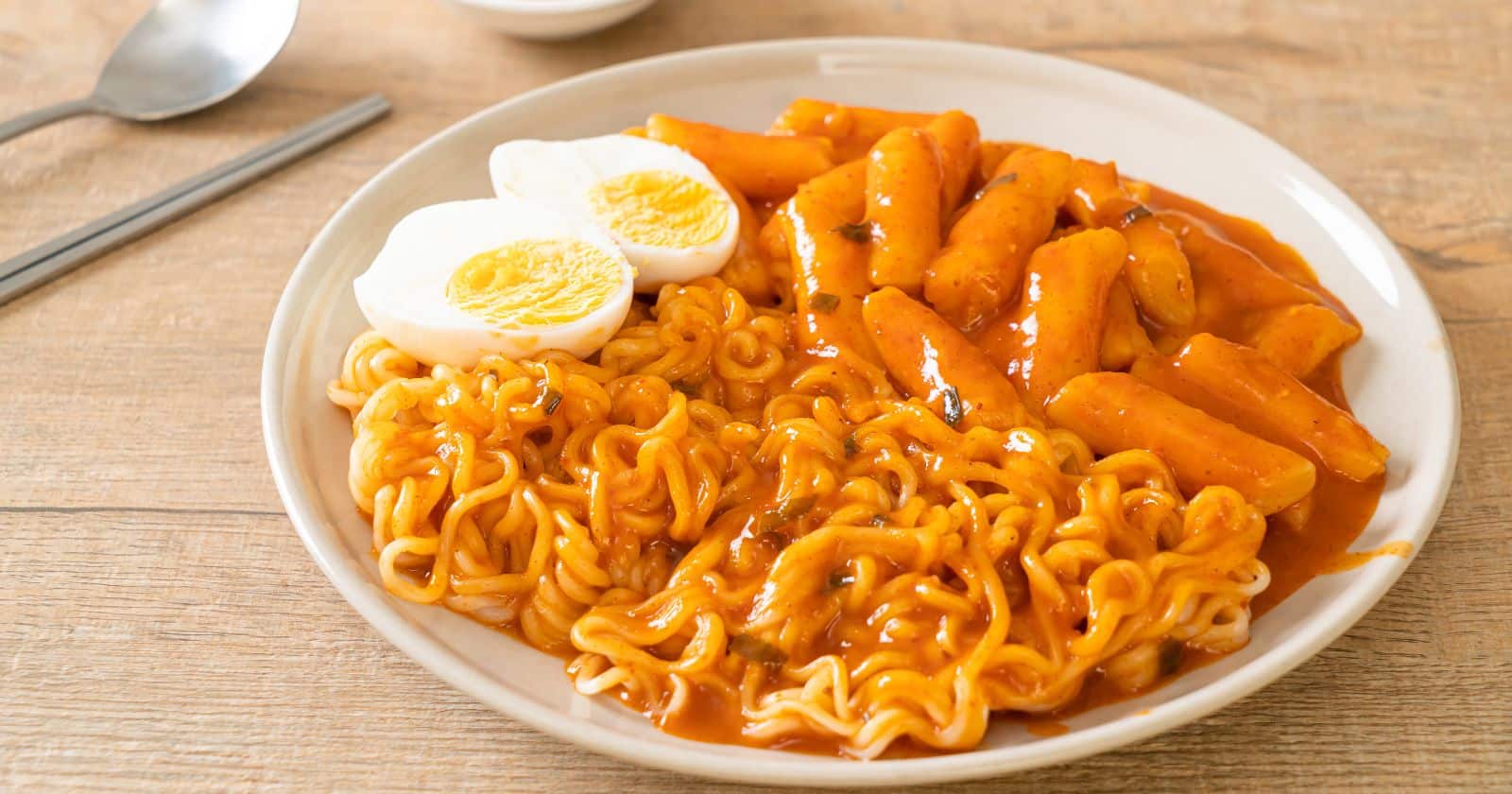Rabokki is a mouthwatering Korean street food that fuses together chewy tteokbokki rice cakes and ramen noodles in a sweet and spicy sauce. This addictive dish has many fans wondering: is rabokki actually healthy for you?
While traditionally loaded with refined carbs and sodium, rabokki can be a nutritious meal when made with some modifications. By swapping a few ingredients and keeping portion sizes in check, you can enjoy this iconic comfort food as part of a balanced diet.
In this article, we’ll explore the origins and ingredients of rabokki, analyze its nutritional value, and provide tips for savoring this Korean favorite in a healthier way. You’ll discover how small tweaks to the classic recipe can maximize nutrition while still delivering on the delicious and satisfying flavors.
Let’s dive in and uncover whether this addictive fusion dish can be good for you when enjoyed mindfully and in moderation. With a few easy recipe hacks, you can feel great about indulging in this irresistible street food!
An Introduction to Rabokki: Fusing Tteokbokki and Ramen
Rabokki combines two classic Korean dishes – tteokbokki and ramen noodles. Tteokbokki are cylindrical rice cakes made from pounded rice flour. They have a soft, chewy texture and absorb flavors easily.
Ramen noodles, originally from China, are now beloved in Korea too. Together, these carbs create a satisfying base for the spicy-sweet rabokki sauce.
The term rabokki blends the words “ramyun”, meaning ramen, and “tteokbokki“. It translates to “ramyun and rice cakes”.
This popular Korean street food is commonly sold at street stalls, snack bars, and restaurants across Korea. It makes for an affordable, filling meal.
The Standard Rabokki Ingredients
Authentic rabokki starts with a few staple ingredients:
- Tteokbokki (rice cakes)
- Ramen noodles
- Fish cakes
- Cabbage
- Gochujang (Korean red chili paste)
- Eggs
Additional mix-ins could include:
- Cheese
- Dumplings
- Meat or seafood
- Sesame oil
- Scallions
The highlights are definitely the soft tteokbokki and tender ramen noodles enveloped in gochujang’s sweet, savory, and spicy flavor.
Now let’s analyze the nutritional value of these ingredients.
Nutritional Profile: Carbs, Protein, and More
Here is the nutritional breakdown of the main rabokki ingredients:
Tteokbokki
- High in carbs from rice flour
- Low in fat
- Minimal protein
- Provides manganese
Ramen Noodles
- High in refined carbs
- Low in fiber, protein, and nutrients
- Often fried, adding fat
- High sodium content
Fish Cakes
- Lean source of protein
- Low in saturated fat
- Contains omega-3s
- Good amount of iron
Cabbage
- Low in calories and carbs
- High in vitamin C and K
- Contains antioxidants
Eggs
- High-quality protein
- Vitamins A, B2, B5, B12
- Antioxidants like lutein and zeaxanthin
Gochujang
- Provides capsaicin from chili peppers
- Contains antioxidants
- High sodium content
Based on this breakdown, rabokki offers a mix of carbs, plant and animal protein, several vitamins and minerals, and beneficial plant compounds. But the high refined carb and sodium content are downsides.
Is Rabokki Healthy Overall?
Given its nutrient profile, here are some key points on rabokki’s health impacts:
Benefits
- Tteokbokki rice cakes offer manganese and carbs for energy.
- The egg and fish cakes provide high-quality proteins.
- Vitamin C is abundant in the cabbage.
- Gochujang offers antioxidants and capsaicin.
Drawbacks
- Refined carbs from the noodles lack nutrients.
- High sodium levels from sauce and noodles.
- Minimal fiber since the rice cakes and ramen are processed.
- May be high in calories when loaded with add-ins.
The Verdict
Overall, rabokki made from scratch with whole food ingredients can be a relatively balanced meal. But the high sodium and refined carbs are downsides, especially for frequent consumption.
Modifying the recipe to include more produce, using reduced sodium noodles, and limiting portion sizes makes rabokki a healthier option.
Tips for Enjoying Rabokki More Healthfully
Here are some easy ways to maximize the nutrition and minimize negatives of your rabokki:
- Use whole grain or vegetable noodles instead of refined ramen.
- Mix in extra vegetables like spinach, onion, zucchini.
- Skip the processed fish cakes and use fresh or canned seafood.
- Opt for low-sodium broth and sauce.
- Balance out the meal with side dishes like kimchi or pickled veggies.
- Watch your portion size as rabokki can be high in calories.
- Savor it as an occasional treat, not an everyday meal.
With smart tweaks and moderation, you can still enjoy delicious rabokki while optimizing its nutritional value.
Exploring Authentic Rabokki Recipes
Once you understand rabokki basics, it’s time for the fun part – making it! Here are two authentic recipes to try.
Traditional Rabokki
Prep Time: 30 mins
Cook Time: 10 mins
Servings: 2
Ingredients
- 1 cup sliced tteokbokki
- 2 cups vegetable broth
- 3 ounces ramen noodles
- 1 cup cabbage, chopped
- 2 fish cakes, sliced
- 3 tablespoons gochujang
- 1 tablespoon soy sauce
- 1 teaspoon sesame oil
- 2 eggs, hard boiled and peeled
- Scallions, chopped
Instructions
- Simmer tteokbokki in broth over medium heat for 10 minutes until soft.
- Add noodles and cabbage. Cook 2 minutes.
- Stir in fish cakes, gochujang, soy sauce, and sesame oil.
- Divide between two bowls and top with egg and scallions.
Spicy Cheese Rabokki
Prep Time: 20 mins
Cook Time: 10 mins
Servings: 2
Ingredients
- 1 cup tteokbokki
- 3 cups vegetable broth
- 4 ounces ramen noodles
- 1 cup cabbage, chopped
- 1 tablespoon gochujang
- 1 tablespoon soy sauce
- 2 slices American cheese
- Scallions, sliced
Instructions
- In a pot, simmer tteokbokki in broth for 5 minutes.
- Add noodles and cabbage. Cook 3 minutes.
- Mix in gochujang, soy sauce, and cheese. Stir until melted.
- Garnish with scallions before serving.
Get creative and add your own flair to these rabokki recipes! Adjust
Key Takeaways on Rabokki’s Health Impacts
To recap, here are the key points on whether rabokki is healthy:
- It provides carbs, protein, some vitamins and minerals.
- Refined carbs and high sodium levels are downsides.
- Modifying the recipe can maximize nutrition.
- Enjoyed in moderation, it can be part of a balanced diet.
- With smart tweaks, you can make healthier versions at home.
So savor rabokki as an occasional indulgence, perhaps swapping some ingredients for healthier options. This iconic Korean street food is all about balance – combining bold flavors and nutrition.





